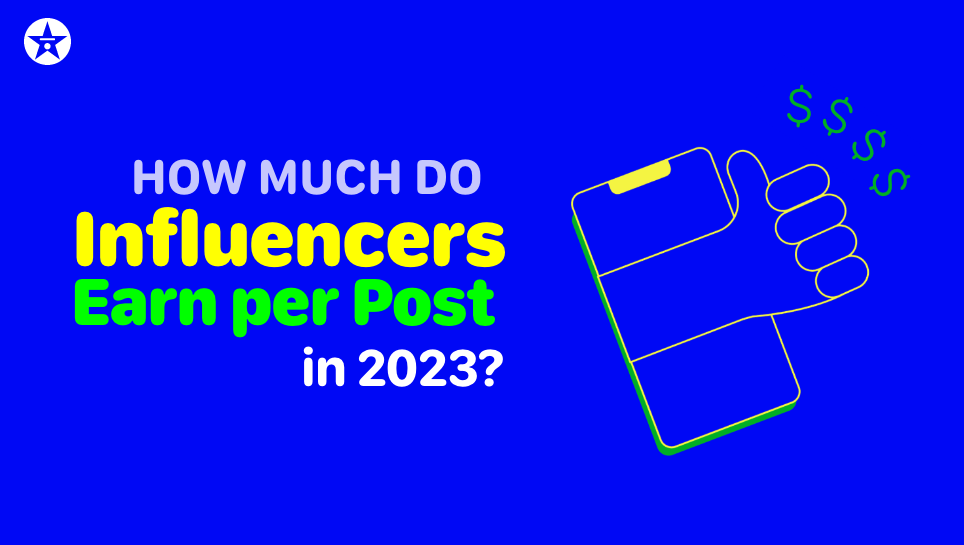How Much Influencers Earn per Post.
Influencers earnings in 2023 are dependent on quite a few factors. Here, we’re sharing the average influencer earnings per post based on the type of influencer and social media platform.
According to this source, the top 4 social media platforms for influencer marketing are:
- Instagram (93%)
- TikTok (68%)
- YouTube (48%)
- Twitter (32%)
Let’s look at the numbers:
RELATED: Power of Influencer Marketing: Boosting Your Brand’s Reach and Engagement
The amount influencers earn per post can vary widely and depends on several factors, including their level of influence, niche, engagement rate, platform, and the brand they collaborate with. Influencer earnings can range from a few hundred dollars to several thousand dollars per post. Some macro-influencers with millions of followers and high engagement rates can earn tens of thousands of dollars per post, especially if they are working with prestigious brands or promoting products in lucrative industries.
However, it’s important to note that these figures are not fixed, and there is no standard rate across the industry. Influencers negotiate their fees with brands on a case-by-case basis, considering factors such as the scope of work, exclusivity, usage rights, and campaign duration. Additionally, influencers may also receive compensation in the form of free products, discounts, or other incentives, which can affect the monetary value of their collaborations.
It’s worth mentioning that the influencer marketing landscape is constantly evolving, and the rates influencers charge can fluctuate based on market demand, industry trends, and the influencer’s own growth and reputation.
Average Influencer Earnings per Post
- Nano-influencers: 1,000–10,000 followers
- Twitter: $2-$20 per post;
- TikTok: $5-$25 per post;
- YouTube: $20-$200 per video;
- Instagram: $10-$100 per post
- Micro-influencers: 10,000–50,000 followers
- Twitter: $20-100 per post;
- TikTok: $25-$125 per post;
- YouTube: $200-$1,000 per video;
- Instagram: $100-$500 per post
- Mid-tier influencers: 50,000–500,000 followers
- Twitter: $100-$1,000 per post;
- TikTok: $125-$1,250 per post;
- YouTube: $1,000-$10,000 per video;
- Instagram: $500-$5,000 per post
- Macro-influencers: 500,000–1,000,000 followers
- Twitter: $1,000-$2,000 per post;
- TikTok: $1,250-$2,500 per post;
- YouTube: $10,000-$20,000 per video;
- Instagram: $5,000-$10,000 per post
- Mega-influencers: 1,000,000+ followers
- Twitter: $2,000+ per post;
- TikTok: $2,500+ per post;
- YouTube: $20,000+ per video;
- Instagram: $10,000+ per post
- Celebrities: 1,000,000+ followers
- Twitter: up to $200k+ per post;
- TikTok: up to $1M+ per post;
- YouTube: up to $2M+ per video;
- Instagram: up to $1M+ per post
7 Factors That Impact Influencer Rates
Numerous factors come into play when determining the fees charged by influencers for their services, making it uncommon to encounter influencers with a fixed rate. Influencer marketing operates as a bona fide business, with rates set by influencers based on what brands are willing to pay. While our list may not encompass all the elements influencing an influencer’s pricing, the following factors reliably contribute to the overall impact:
- Audience size and engagement: The size and level of engagement of an influencer’s audience significantly affect their rates.
- Niche and industry relevance: Influencers specializing in specific niches or industries may charge varying rates based on the demand and exclusivity of their expertise.
- Content quality and creativity: The level of creativity and quality of content produced by an influencer can influence their perceived value and subsequently affect their pricing.
- Reach and platform: The reach and platform utilized by an influencer, whether it’s Instagram, YouTube, or others, play a role in determining their rates.
- Campaign duration and exclusivity: Influencers may charge higher fees for longer campaign durations or if they need to provide exclusive endorsements.
- Past collaborations and brand reputation: Previous successful collaborations and a positive brand reputation can contribute to an influencer’s pricing.
- Overall market demand: The general demand for influencer marketing and the specific demand for an influencer’s services within the market can impact their rates.
While this list is not exhaustive, it highlights several key factors that exert an influence on how much an influencer may charge for their services.
Follow / Subscribe:
Related posts


Learn More ›
Latest Articles
Subscribe to Newsletter
- DTC marketing news and trends—tracking the industry ups and downs Source: Ad Age-Latest Published on 2023-09-25
- Hollywood Screenwriters reach tentative deal to end strike Source: Ad Age-Latest Published on 2023-09-25
- Hollywood Screenwriters reach tentative deal to end five-month strike Source: Ad Age-Latest Published on 2023-09-25
- What Gen Z loves—and hates—about brand marketing Source: Ad Age-Latest Published on 2023-09-25




Stay connected